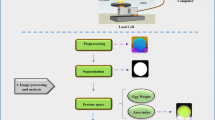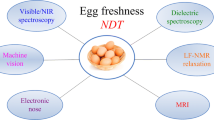Abstract
Recently, rapid and nondestructive technologies have been developed in the qualification of food products. This research aimed to design and develop an egg qualifying system based on dielectric technology in the range of radio frequency (40 kHz to 20 MHz), machine vision, and artificial neural network (ANN) techniques. Haugh unit, yolk index, yolk/albumen ratio, and yolk weight were studied as quality factors of egg. The designed electronic device was calibrated and evaluated for prediction of the mentioned parameters. The coefficient of determination (R 2) values in the validation of the ANN were 0.998, 0.998, 0.998, and 0.994 for the Haugh unit, yolk index, yolk/albumen, and yolk weight, respectively. In evaluation mode, the mean absolute percent errors (MAPEs) obtained were 5.41, 6.84, 8.79, and 4.24 % for the Haugh unit, yolk index, yolk/albumen, and yolk weight, respectively. Results of the evaluation showed the designed device can be confidently used in the prediction of egg quality indices.








Similar content being viewed by others
References
Abbott JA (1999) Quality measurement of fruits and vegetables. Postharvest Biol Technol 15:207–225
Abdel-Nour N, Ngadi M, Prasher S, Karimi Y (2011) Prediction of egg freshness and albumen quality using visible/near infrared spectroscopy. Food Bioprocess Tech 4:731–736
Aboonajmi M, Akram A, Nishizu T et al (2010) An ultrasound based technique for the determination of poultry egg quality. Res Agric Eng 56:26–32
Asadi V, Raoufat MH (2010) Egg weight estimation by machine vision and neural network techniques (a case study fresh egg). Int J Nat Eng Sci 4:1–4
Dehrouyeh MH, Omid M, Ahmadi H et al (2010) Grading and quality inspection of defected eggs using machine vision. Int J Adv Sci Technol 17:23–30
Funk EM (1948) The relation of the yolk index determined in natural position to the yolk index, as determined after separating the yolk from the albumen. Poult Sci 27:367
Guo W, Wu X, Zhu X, Wang S (2011) Temperature-dependent dielectric properties of chestnut and chestnut weevil from 10 to 4500 MHz. Biosyst Eng 110:340–347
Haugh RR (1937) A new method for determining the quality of an egg. US Egg Poult 39:27–49
Javanaud C (1988) Applications of ultrasound to food systems. Ultrasonic 26:117–123
Kemps BJ, Bamelis F, Katelaere D et al (2006) Visible transmission spectroscopy for the assessment of egg freshness. J Sci Food Agr 86:1399–1406
Kemps BJ, De Katelaere B, Bamelis F et al (2007) Albumen freshness assessment by combining visible near-infrared transmission and low resolution proton nuclear magnetic resonance spectroscopy. J Poult Sci 86:752–759
Knorr D, Zenker M, Heinz V, Dong-Un L (2004) Application and potential of ultrasonic in food processing. Trends Food Sci Tech 15:261–266
Koc AB (2007) Determination of watermelon volume using ellipsoid approximation and image processing. Postharvest Biol Technol 45:366–371
Kuchida K, Fukaya M, Miyoshi S (1999) Nondestructive prediction method for yolk:albumen ratio in chicken eggs by computer image analysis. Poult Sci 78:909–913
Kumhala F, Prosek V, Kroulik M (2010) Capacitive sensor for chopped maize throughput measurement. Comput Electron Agric 70:234–238
Lin H, Zhao JW, Chen QS, Cai JR, Zhou P (2009) Eggshell crack detection based on acoustic response and support vector data description algorithm. Eur Food Res Technol 230:95–100
Liu Y, Ying Y, Ouyang A, Ouyang A, Li Y (2007) Measurement of internal quality in chicken eggs using visible transmittance spectroscopy technology. Food Control 18:18–22
MathWorks (2012) MATLAB user’s guide. The MathWorks Inc, USA
Mollazade K, Omid M, Arefi E (2012) Comparing data mining classifiers for grading raisins based on visual features. Comput Electron Agric 84:124–131
Nelson SO, Guo W, Trabelsi S, Kays S (2007) Dielectric spectroscopy of watermelons for quality sensing. Meas Sci Technol 18:1887–1892
Omid M, Baharlooei A, Ahmadi H (2009) Modeling drying kinetics of pistachio nuts with multilayer feed-forward neural network. Dry Technol 27:1069–1077
Omid M, Soltani M, Dehrouyeh MH et al (2013) An expert egg grading system based on machine vision and artificial intelligence techniques. J Food Eng 118:70–77
Pan LQ, Zhan G, Tu K, Tu S, Liu L (2011) Eggshell crack detection based on computer vision and acoustic response by means of back-propagation artificial neural network. Eur Food Res Technol 233:457–463
Patel VC, McClendon RW, Goodrum W (1998) Color computer vision and artificial neural networks for the detection of defects in poultry eggs. Artif Intell Rev 12:163–176
Ragni L, Berardinelli A, Guarnieri A (2008) A dielectric technique based on a one-chip network analyser to predict the quality indices of shell eggs. Biosyst Eng 100:470–478
Ragni L, Cevoli C, Berardinelli A (2010) A waveguide technique for non-destructive determination of egg quality parameters. J Food Eng 100:343–348
Sacilik K, Colak A (2010) Determination of dielectric properties of corn seeds from 1 to 100 MHz. Powder Technol 203:365–370
Trabelsi S, Nelson SO (2006) Nondestructive sensing of bulk density and moisture content in shelled peanuts from microwave permittivity measurements. Food Control 17:304–311
Acknowledgments
The authors would like to acknowledge the Center of Research and Development of ETKA Organization for providing financial support to this research. The authors would also like to thank the Department of Agricultural Machinery Engineering, Faculty of Agricultural Engineering and Technology, University of Tehran for their contributions to this study.
Conflict of Interest
Mahmoud Soltani, Mahmoud Omid, and Reza Alimardani declare that they have no conflict of interest. This article does not contain any studies with human or animal subjects.
Author information
Authors and Affiliations
Corresponding author
Rights and permissions
About this article
Cite this article
Soltani, M., Omid, M. & Alimardani, R. Egg Quality Prediction Using Dielectric and Visual Properties Based on Artificial Neural Network. Food Anal. Methods 8, 710–717 (2015). https://doi.org/10.1007/s12161-014-9948-x
Received:
Accepted:
Published:
Issue Date:
DOI: https://doi.org/10.1007/s12161-014-9948-x




